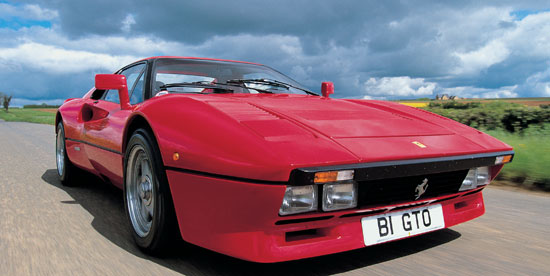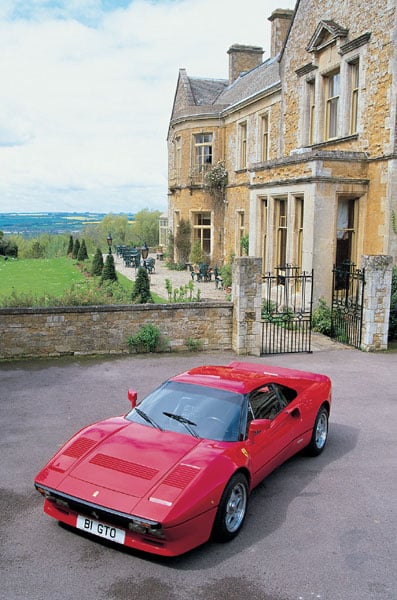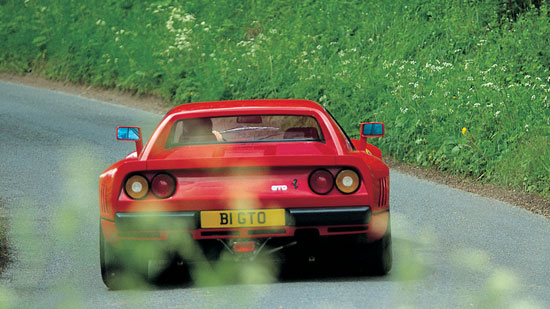
The following is an edited extract from Auto Italia magazine, July 2004. For access to the full feature, plus articles on the Alfa Romeo Bimotore, the Pagani Zonda, 2004 Villa d'Este Concours and much more, see www.auto-italia.co.uk
This GTO once had to put up with everything Eddie Irvine could throw at it. Its present owner, Andrew Jewson, is an old pal of Eddie’s and relieved him of this particular toy last year. Now he, too, wants to sell it, but was kind enough to let us play with it for a day first.
 The 288GTO, along with its arch-rival the Porsche 959, is a supercar milestone. For most of the ’70s and early ’80s ultimate road car power and performance figures had remained on a plateau. Brake horsepower in the mid/late 300s, 160-175mph and 0-60 in the low ‘fives’ were the benchmark. Then in 1982 the FIA introduced Group B, for 200-off race and rally machines, and the world went homologation-crazy. A new dawn was breaking and when Maranello’s protagonist finally appeared at the 1984 Geneva Show, the overblown ‘Testosterossa’, latest and lardiest in a series of imperious, range-topping 12-cylinder berlinettas, found its thunder nicked by this upstart V8 underling.
The 288GTO, along with its arch-rival the Porsche 959, is a supercar milestone. For most of the ’70s and early ’80s ultimate road car power and performance figures had remained on a plateau. Brake horsepower in the mid/late 300s, 160-175mph and 0-60 in the low ‘fives’ were the benchmark. Then in 1982 the FIA introduced Group B, for 200-off race and rally machines, and the world went homologation-crazy. A new dawn was breaking and when Maranello’s protagonist finally appeared at the 1984 Geneva Show, the overblown ‘Testosterossa’, latest and lardiest in a series of imperious, range-topping 12-cylinder berlinettas, found its thunder nicked by this upstart V8 underling.
With 400bhp on tap (thanks to the emergent art of turbocharging), 60mph took under five seconds and 190-plus was a reality. These were magic figures 20 years ago, a quantum leap forward that continued exponentially as GTO begat F40, and F40 begat F50, and F50 begat Enzo, and…well, who knows? So what makes the iconic GTO special – and justifies its £185k value – even in the cosy, claustrophobic confines of Middle England?
Giorgetto Giugiaro once generously described Leonardo Fioravanti’s 308GTB as “the most perfect car I’ve ever seen” and the 288, if anything, improves on it, with its swollen arches and 110mm-longer wheelbase (to accommodate a longitudinal rather than transverse engine, for easier pit-lane servicing). Unlike the all-steel 308, the GTO’s bodywork is an exotic cocktail of GRP, Kevlar, Nomex, aluminium and steel, saving 140kg. The most beautiful of all Ferraris? It makes a good case for itself. Aside from the ravishing basic shape, detailing is superb. Look, for example, at the three inclined vents behind the rear wheelarches (a homage to the car’s legendary 250GTO forebear) – functional, simple, inspired. As is the interior. Like many low-slung exotics, a dignified, pain-free entry requires a sort of corkscrew action to ensure clearing both sills and roof. Inside, there’s lots of black velvety fabric trim, creating a purposeful, minimalist ambience that’s also light and airy, thanks to the generous fenestration. You sit a bit low in relation to the classic three-spoke wheel – no airbags here – but the leather seats are supportive and comfy (initially at least – after an hour or two my buttocks weren’t so sure).
The twin-turbo V8 is based on the 268C engine developed by Ferrari from the 308 for the Lancia LC2 Group C car, its 2,855cc capacity chosen to provide a nominal four litres under the FIA’s equivalency rule for turbo engines (multiply by 1.4).
Heading west on the A40, I relax, gather my thoughts and start to upload those crucial first impressions. The car gives good feedback, via a lively but far from uncomfortable ride, and steering that transmits terrific feel, the wheel dancing lightly between your fingers. The gearchange is Ferrari-familiar – longish throws, needing a firm hand, but at least you can see where it’s going – and the clutch surprisingly light. A clear run at a roundabout confirms a pedal layout perfect for toe-heeling, just as it should be. I trundle along contentedly until a clear straight beguiles me into sidling past a couple of dawdlers.
Not much lag, then a lunge that is, literally, breathtaking. I’ve always liked turbos, but now it’s lurve. There’s that spine-tingling whistle as the boost gauge chases the 320km/h speedo, and I can certainly hear the engine now – still a bit flat-sounding, but harder, louder – much louder. I don’t like what I’m seeing on the clock, though, so I grab fourth, lift off, breathe deeply and grin vacantly. Where did those two cars go?
Some more open stretches allow me to drop back and explore the 288’s handling. Now I begin to understand the drooling hyperbole of early GTO road tests. The precision of the tubular space-frame chassis is extraordinary, and the stiletto-sharp steering really comes into its own, transmitting every nuance of the car’s posture in response to driver input.
Turning in with racer-like accuracy, sucked onto the road by leech-like Michelins, the 288’s cornering powers are awe-inspiring today. Twenty years ago they must have been almost beyond belief. Totally, predictably neutral, only tighter corners entered quickly bring a hint of understeer, sensed really only through the steering’s increased weight, and nowhere around these parts will you come close to unsticking the rear end.
The early demise of Group B ensured that few of the 273 original GTOs built have a competition history, but there’s something irresistible about the uncompromised, elemental purity of road-racers like this. The 288 is a 20-year-old car with the straight-line speed of a new 360, but with no interfering computer trying to take over each and every function, dumbing-down the driving experience in the process. It makes for much harder work but here the sensations come raw and undiluted – full-bodied and 100 percent proof, like a Stratos on steroids.
 |
 |
 |

|
Words by Simon Park. Pictures courtesy of Phil Ward and Auto Italia magazine.
See www.auto-italia.co.uk or call 01858 438817 for back issues and subscriptions. |




